2015-11-02 By Ed Timperlake and Robbin Laird
Fifty years ago, 1965, in Bancroft Hall at the United States Naval Academy, Plebes (freshmen) were required when making a very loud announcement to a gathering of fellow Midshipman to began with the alert-“attention world, attention world.”
It was a time when some of those who had fought WWII in the great “Big Blue Blanket” war winning con-ops were still in uniform, several of the Navy Pilots who were featured in the great work “the Bridges of Toko-Ri” were still in uniform, and Vietnam Yankee and Dixie station Carriers were beginning to fight that war.
From Plebe to Four Star Admirals, all in the United States Navy and Marine Corps were constantly engaged and challenged in understanding and mastering the dynamic nature of war at sea and the role of Navy/Marine power projection from across the beach. In those days sailors still in uniform wearing the Dolphins of the “silent service,” the Navy Submarine Community, would proudly point out that with the loss of 52 subs “still on patrol” they actually sunk over 50% of the tonnage of the Imperial Japanese Navy in WWII.
In WWII the Fleet Carriers captured in a famous picture “murders row” carried the fight to the enemy and victory.
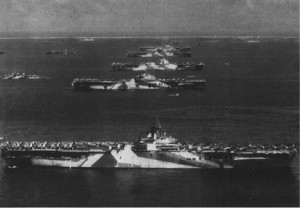
It was costly in ships and crews lost.
In the Korean War and Vietnam War, the carriers could operate close to the battlefield and the fight was aggressively pursued by the pilots.
Desert Storm, shorter in duration, again had the luxury of Carriers essentially operating with total sea dominance.
Since those 20th Century combat engagements,everything has changed and nothing has changed.
The US Navy’s Nimitz Class and soon to be Ford Class aircraft Carriers, the most complex and demanding engineering accomplishment ever built in the history of the world, are still a significant and necessary critical component of America’s national security.
The combat function of a carrier designed and crewed to go into battle in any ocean from the Arctic, to the Equator, to the Antarctic is still essential, that has not changed.
The ability at all ranks of the fighting Navy to understand the strengths and weakness of their weapons and train train, train has not changed.
The combat imperative to understand how to fight with all the “ships at sea” in air enabled combat has not changed.
Carriers both large Nimitz/Ford and the smaller ones USS America and others in the Navy/Marine Amphibious forces, along with surface combatants and submarines engaging against a determined well equipped reactive enemy has not changed.
The teaming of the fighting Navy with a fighting Air Force has not changed and understanding how to build fighting alliances with other nations military has not changed.
What has changed is profound.
Because of historic advances in communications coupled with the power of computer, a combat learning 21st Century way of war is now with all combat forces in the world.
How the most senior leaders capture and exploit this dynamic ever evolving revolution is the key to victory in combat.
Dynamic combat learning empowered by a sensor information processing command and control technological imperative is now the key to victory.
It is the melding of a computer-human interface that can make a huge difference if understood and employed correctly.
In the cockpit the F-35 “z-axis” a revolution in air combat can start from the cockpit out.
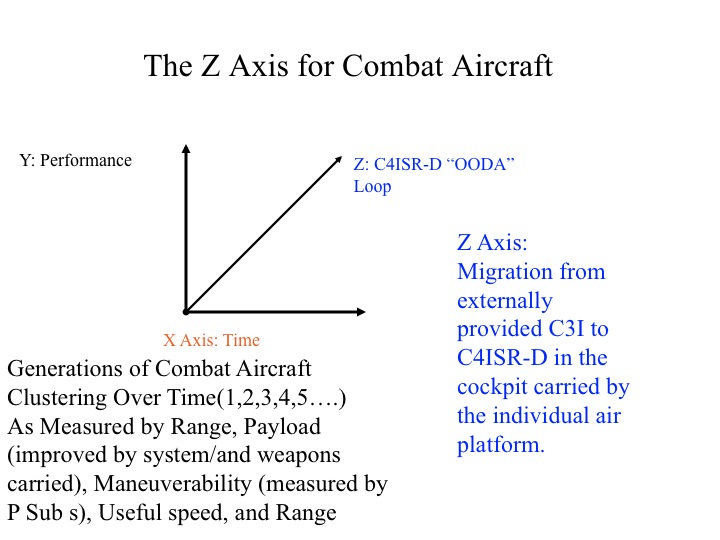
But as the F-35 is a catalyst for this 21st Century way of war from cockpit out, other combat systems are synergistically connected from the commanders at all levels of the fight.
From legacy aircraft such as F/A-18 to E-2s, Aegis, and other fleet elements, combat commanders at all levels need to learn how to accept and use the information presented to fight, adjust, fight, adjust and win.
The commanders have to practice over and over to evolve a much broader scope of understanding and direction in this 21st Century information world.
It is a 21st Century challenge to understand the dynamic learning from a computer-human interface while also recognizing it is the goal of a reactive enemy to attempt to destroy not only individual platforms, sink ships and subs and shoot down aircraft, but wreck the very synapses of all things command and control.
Information assurance with redundancy and reliability is critical but also the ability to act independently as systems are degraded to fight and win cannot be forgotten in all training exercises.
The enemy always gets a vote but so does the United States Navy.
The decade ahead is not a repeat of the past 15 years; it is not about a continuation of the land-centric and counter-insurgency slow motion war.
It is about global agility, the ability to insert force to achieve discrete and defined objectives, and to maneuver in the extended battlespace to work with allies and joint forces to credibly prevail in the range of military conflict across the range of military operational situations.
For the power projection forces –USN/ USMC, USAF with appropriate elements of the US Army, especially Air Defense Artillery – it is about the capability to work across an extended battlespace with flexible means which can be linked together as necessary to prevail in the military and strategic conditions facing the US and its allies in the period ahead.
It is about building capabilities at the high end, which have the flexibility to operate through the range of military operations or ROMO.
It is about powerful and flexible force packages which can operate and dominate in specific military situations but be linked to other capabilities to provide the kind of reachback and dominance which effective deterrence requires.
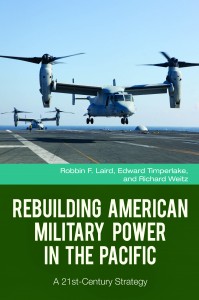
In our book on the Rebuilding American Military Power in the Pacific: A 21st Century Strategy, we highlighted several key elements required to shape 21st century war winning deterrent forces.
By leveraging some of the new platforms coming online and replacing older, costly, and stove-piped platforms and systems, a new scalable force structure can be built. And at the heart of doing so will be the inclusion of allies and U.S. forces within a modular scalable structure.
The strategy is founded on having platform presence. By deploying assets such as USCG assets— for example, the national Security Cutter, USN surface platforms, Aegis, or other surface assets— by deploying subservice assets, and by having bases forward deployed, the United States has core assets that if networked together and end a stovepiped acquisition strategy of platforms bought separately from one another can make significant gains in capability possible. Scalability is the crucial glue to make a honeycomb force possible…..
Two other key elements are basing and weaponization. Basing becomes transformed as allied and U.S. capabilities become blended into a scalable presence and engagement capability. Presence is rooted in basing; scalability is inherently doable because of C5ISR enablement, deployed decision-making, and honeycomb robustness.
The reach from Japan to South Korea to Singapore to Australia is about how allies are reshaping their forces and working toward greater reach and capabilities. For example, by shaping a defense strategy that is not simply a modern variant of Seitzkreig in South Korea and Japan, more mobile assets allow states in the region to reach out, back, and up to craft coalition capabilities.
The approach we have suggested is built around “no platform fights alone,” whereby we look at key platforms as nodes in a honeycomb force which can act with effective lethality throughout an extended battlespace.
Those platforms which can operate in an interconnected manner are the crucial ones to build, deploy and sustain in the period ahead, versus those which are very limited in their capability to provide synergy to joint or coalition forces in the battlespace.
This means as well that force packages need to be examined, less in and of themselves terms, than in terms of their synergy and capabilities in shaping dominant combat power in the interconnected battlespace.
Although seemingly obvious, as the current Deputy Chief of Staff of the Royal Australian Air Force, Air Vice Marshal McDonald, puts it: Even with the blindingly obvious, sometimes you have to be quite innovative to make that blinding obvious come into an executable outcome.
The large-deck aircraft carrier is a clear case in point.
The USS Ford will not be simply a continuation of the Nimitz class carrier, but even the upgraded Nimitz class carriers under the influence of the dynamics of change in their airwing, as well as they systems with which they will connect at sea or in the air or over land will change their contribution as well to an integrated fighting force.
Two recent studies have both concluded that the air wing being currently modernized is the wrong choice for the US Navy and do so for a variety of reasons.[ref] http://breakingdefense.com/2015/10/carriers-crucial-in-war-with-china-but-air-wing-is-all-wrong-hudson/; http://www.hudson.org/research/11731-sharpening-the-spear-the-carrier-the-joint-force-and-high-end-conflict; http://www.cnas.org/retreat-from-range#.VjdOCYRuY7k[/ref]
These studies suggest dispensing with the current air wing and building instead specialized longer-range unmanned and manned assets where range is the critical variable for the aircraft flying FROM the carrier.
Leaving aside the small fact that PowerPoint airplanes only kill the audience listening to the brief, the modernization plans of the US Navy are the baseline from which combat capabilities will be generated from the carrier decks.
And the recent Russian actions have clearly shown the limits of current unmanned technology to operate in contestable airspace.
Totally ignored is the question of the reach of the aircraft in the networked battle space.
And the Navy is focusing on building out the capabilities of a multi-mission and multi-tasking air wing of networked capabilities to shape the reach of the carrier into the battlespace.
No platform fights alone.
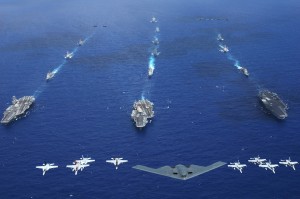
And the real meaning of what the carrier will contribute is not suggested simply by an analysis of what the aircraft carrier can organically do on its own; it is really a question of how the modernization of the air wing alters the capability of the carrier as a highly maneuverable strike asset and shapes convergence and synergy with other elements in the offensive-defensive strike enterprise.
It is the offensive-defensive strike enterprise which is the focus of change whereby key combat elements shape capabilities across an expanded battlespace to rip apart adversary strategies to claim anti-access and area denial capabilities, which a diversified, distributed warfighting force can take apart and destroy.
This is what former Air Force Secretary Michael Wynne calls the attack and defense enterprise. The strategic thrust of integrating modern systems is to create a grid that can operate in an area as a seamless whole, able to strike or defend simultaneously.
This is enabled by the evolution of C5ISR (Command, Control, Communications, Computers, Combat Systems, Intelligence, Surveillance, and Reconnaissance), and it is why Wynne has underscored for more than a decade that fifth generation aircraft are not merely replacements for existing tactical systems but a whole new approach to integrating defense and offense.
By shaping a C5ISR system inextricably intertwined with platforms and assets, which can honeycomb an area of operation, an attack and defense enterprise can operate to deter aggressors and adversaries or to conduct successful military operations.
Inherent in such an enterprise is scalability and reach-back. By deploying the C5ISR honeycomb, the shooters in the enterprise can reach back to each other to enable the entire grid of operation, for either defense or offense.
https://www.sldinfo.com/army-ada-as-key-element-of-21st-century-attack-defense-enterprise/
The modernization of the large deck carrier is seeing several new developments emerge which reshapes its ability to provide synergy across the battlespace.
The new carriers – the USS Ford or the British Carrier the Queen Elizabeth – bring new command capabilities and operational infrastructure which enhance their contributions to other combat capabilities in the battlespace.
The coming of the F-35 puts on the carrier deck a core capability to operate at the edge of the carrier’s battlespace and can reach deep into the operational networks which support each cell of a honeycombed force.
The legacy assets will be modernized under the influence of synergy opportunities as well as fifth generation warfare dynamics to work more effectively in expanding the capabilities of a synergistic joint or coalition force.
Currently, the Super Hornets operating with the new Hawkeye are beginning to demonstrate the expanded reach of the carrier by delivering off boarding weapons capabilities, whereby one asset can direct the fire of another.
The expanded capabilities of the amphibious task force underway under the twin influence of the Osprey and the F-35B changes the impact of the task force as an initial presence force in an engagement.
The ability to reach back to the carrier or to land-based air changes the meaning of the amphibious force and its impact for presence or as the initial insertion force for an engagement.
As the carrier air wing is being modernized, the USAF is undergoing transformation as well which expands the reach of their operational force.
As General “Hawk” Carlisle recently commented about the strategic direction of the modernization of airpower, the growing impact of the F-22 was really about the overall transformation of warfare, not simply adding new platforms.
It is important to look at the impact of the F-22 operations on the total force. We do not wish, nor do the allies wish to send aircraft into a contested area, without the presence of the F-22.
It’s not just that the F-22s are so good, it’s that they make every other plane better. They change the dynamic with respect to what the other airplanes are able to do because of what they can do with regard to speed, range, and flexibility.
It’s their stealth quality. It’s their sensor fusion. It’s their deep penetration capability. It is the situational awareness they provide for the entire fleet which raises the level of the entire combat fleet to make everybody better.”
The shift is to a new way of operating.
And allies adding new air capabilities with an ability to share information over an integrated and expanded battlespace is crucial as well.
The emergence of a global F-35 fleet is a key contributor as well to U.S. and allied capabilities in reaching deeper into the battlespace.
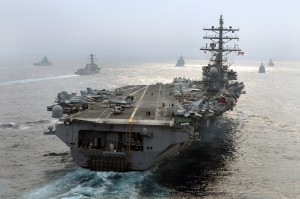
And the capability of the large deck carrier to empower that integration with an increase in distributed lethality is a key element of the combat synergy to operate in the expanded battlespace and to prevail.
The carrier provides a very flexible, and mobile strike and defense asset capable with its evolving airwing to work more effectively with a joint and coalition force to deliver greater synergy.
It is really not a question of building the wrong airwing; it is about understanding how the evolution of the airwing and the large deck carrier intersect with the evolution and transformation of joint and coalition capabilities to prevail in the expanded battlespace to deliver combat synergy for a resilient honeycombed force.
As Vice Admiral Aquilino, the PACFLEET’s Director of Maritime Operations and now Deputy Chief of Naval Operations, Plans and Strategy (N3/N5) put it in an interview in Hawaii earlier this year:
“We need to have the ability to operate where it matters and when it matters. And we can do that.”
He followed the lead of the CNO who emphasizes that if one fights the high end fight, one can adapt to the other challenges; but the reverse is not necessarily true.
We discussed distributed lethality and the evolving US Navy’s joint and coalition approach to deploying diversified and distributed capabilities which can when combined in coordinated concepts of operations deliver what is needed in the area of interest.
“What I think is meant by distributed lethality is an ability to have an agile and diversified force operating over an extended battlespace but with an ability to concentrate force against the crucial tasks, targets and goals to execute an effective strategy.”
http://www.navy.mil/navydata/bios/navybio.asp?bioID=595
Vice Admiral Aquilino sees the carrier as a key part of distributed lethality not just for the sea services but also for the joint and coalition forces.
When asked what technologies are coming to the Pacific which we enable PACFLEET to achieve this strategy more effectively, he quickly focused on the coming of the F-35 to the fleet and to the region.
“I mentioned earlier that our task is clearly that we need to have the ability to operate where it matters and when it matters.
The F-35 will enhance our ability to do so.
Although I am a naval aviator, I am not speaking as one when I make this point about the new aircraft.
It is a force multiplier and enhancer not just a new combat aircraft. It clearly will enhance or air-to-air and air-to-ground capabilities, but it as a deployed and integrated sensor aircraft it extends our reach and expands our flexibility and agility.”
He focused on the F-35’s role organically with PACFLEET (on carriers and on amphibious ships) but also in terms of being able to draw from the sensor stream of a deployed USAF as well as allied force of F-35s.
“The integration of the sensor grid is a crucial and evolving capability which will be expanded as the F-35 enters the Pacific.”
As we put in our book on the evolution of Pacific strategy:
“In World War II, the USN shaped what became called the big blue blanket of ships to cover the Pacific operations. Obviously, this is beyond the ken of current realities, but shaping a connected set of U.S. and allied forces able to work together to shape defense and security in the Pacific is not.”
The Admiral clearly had a similar thought in mind in our discussion.
So much for building the wrong airwing; the question really is to put the modernization of the airwing within a broader context of shaping U.S. joint forces and those of the coalition to fight effectively in the integrated and extended battlespace.
It is not about carriers fighting on their own in the South China Sea with a mythical robotic airwing; it is about real carriers flying real airplanes and participating in the shift in war fighting capabilities and approaches along with the relevant joint force and those of our allies to prevail in the real world conflicts already upon us.

